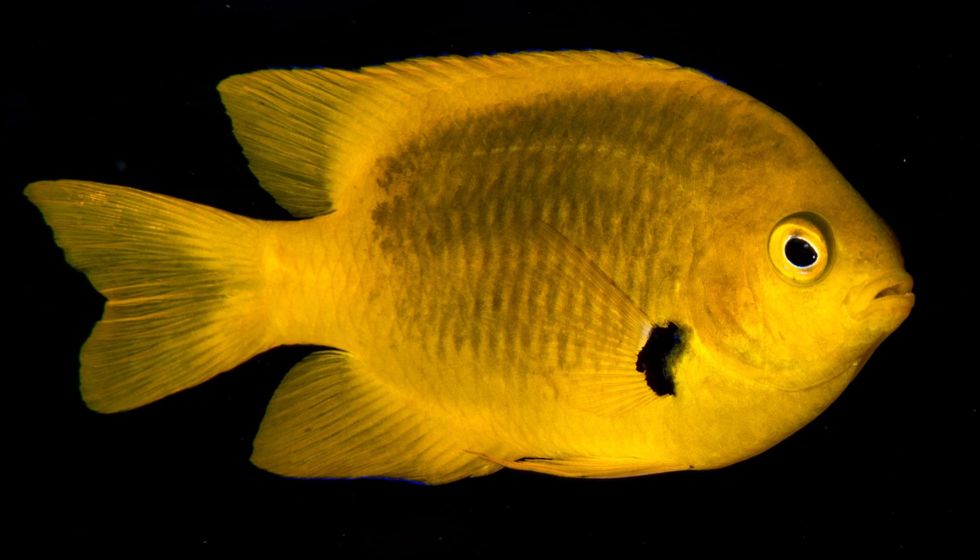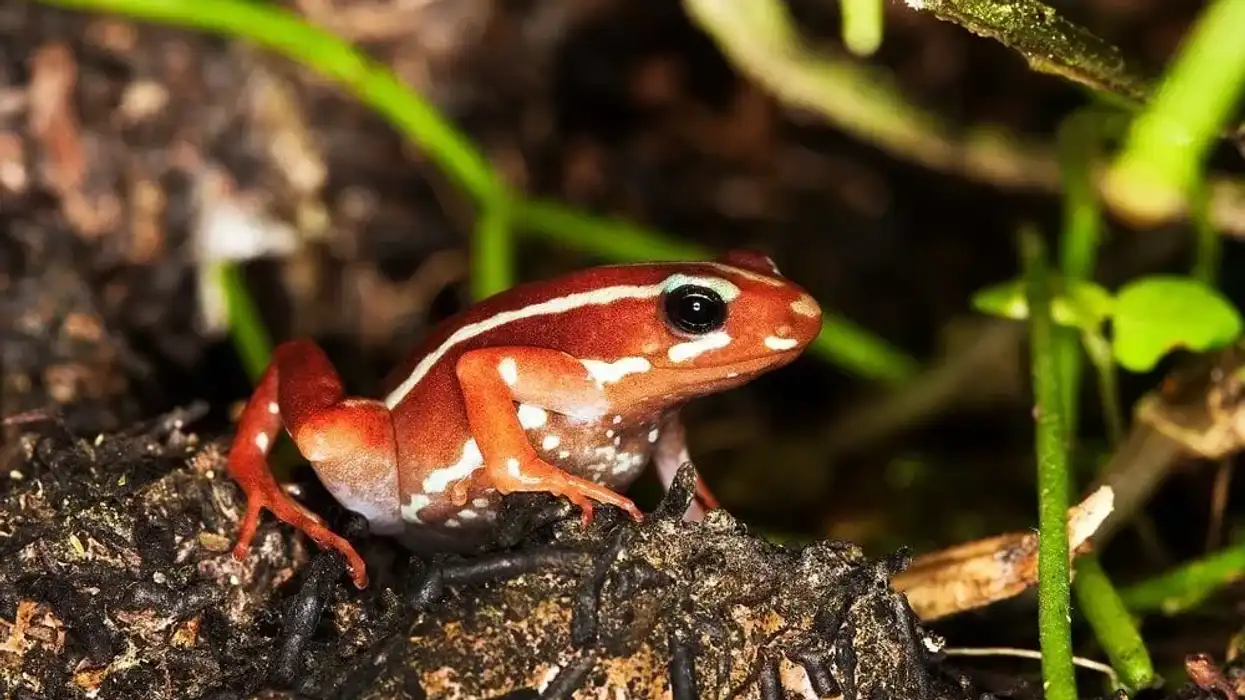The lemon damsel (Pomacentrus moluccensis) is a type of bright yellow, marine reef fish belonging to the Pomacentridae family, which contains damselfish and clownfish.
They can be found living in the western Pacific Ocean, among clearwater lagoons and reef corals. They are highly sought after as pets due to their dazzling color, making them very common in the fish breeding industry.
These fish are quite small, reaching an average length of 3.5 in (9 cm) and can be distinguished from other yellow fish by the presence of a distinct orange spot near their pectoral fins.
Despite the aggressive reputation of damselfish, the lemon damselfish is not as bad as it is made out to be and can be conditioned to get along very well with its aquarium mates. They love to dart and hide among the tank as they are used to living among the reef corals.
To learn more about these not-so-dainty damsels, read on! For more relatable content, check out these black dragonfish facts and green sunfish facts for kids.
Lemon Damsel Interesting Facts
What type of animal is a lemon damsel?
The lemon damsel (Pomacentrus moluccensis) is a type of yellow damselfish belonging to the Pomacentridae family.
What class of animal does a lemon damsel belong to?
The lemon damsel belongs to the class Actinopterygii of ray-finned fishes.
How many lemon damsels are there in the world?
Though the exact number of these fish in the world is unknown, we do know that they are popular as pets all over the world due to their stunning yellow luminescent scales that can brighten up any aquarium.
Where does a lemon damsel live?
The lemon damsel can be found living in the Pacific Ocean, mostly among Caribbean coral reefs and clearwater lagoons.
What is a lemon damsel's habitat?
The lemon damselfish prefers living in tropical and subtropical waters with warm temperatures. This fish can be observed hiding among the corals and lounging in lagoons.
Who do lemon damsels live with?
They can mostly be found in schools with fish of their own species. However they can become aggressive with each other at times, especially during the breeding season.
They are generally territorial towards outsiders and enjoy their own space. This fish is less aggressive than other damselfish species and can learn to get along well in a tank if incorporated early.
How long does a lemon damsel live?
Damselfish are known to live anywhere from five to six years.
How do they reproduce?
Golden damselfish are oviparous in nature, meaning they reproduce by laying eggs. Males perform a vigorous 'signal jump' to impress the female, after which they pair up and mate.
Females are known to lay up to 20,000 eggs among the reef substrate which are guarded by the male. The fertilized eggs take anywhere from 3-10 days to hatch if they are healthy, releasing a whole bunch of fry.
What is their conservation status?
The current conservation status of the lemon damsel is Not Evaluated and simply stated as non-extinct. However, as it is a much sought-after fish by aquarium enthusiasts, it is bred in plenty and it is safe to assume that their numbers are in abundance.
Lemon Damsel Fun Facts
What do lemon damsels look like?
Lemon damsels (Pomacentrus moluccensis), true to its name, are small fish that are sunshine bright yellow in color. They have a single, long dorsal fin on their top and an anal fin on the bottom.
There is one pectoral fin on each fin, with the usual presence of a bright orange spot near them. They have round, large eyes on each side of their head and two rows of slightly rounded teeth inside their mouths.

We've been unable to source an image of a Lemon Damsel and have used an image of a Damsel Fish instead. If you are able to provide us with a royalty-free image of a Lemon Damsel, we would be happy to credit you. Please contact us at hello@kidadl.com.
How cute are they?
With their tiny size and beautiful, sunny color, these fish are adorable to look at.
How do they communicate?
Swimming among the coral reefs, these fish can communicate with each other using a variety of chemical signals.
Yellow damselfish can release chemicals called pheromones to communicate with other members of their own species, and allelochemicals to communicate with other species. They can relay a range of messages such as the intent to mate, presence of food or intruders, or distress.
They also communicate through gestures, especially in the breeding period where the male performs a high energy 'signal jump' to woo the female, rising up water columns, and swimming down rapidly.
How big is a lemon damsel?
The lemon damselfish is a relatively small aquarium fish which measures 3.5 in (9 cm) from head to tailfin. They are a bit smaller than jewel damsels and dusky damselfish.
How fast can a lemon damsel swim?
The exact speed of this fish is unknown. As they mostly stay in one place throughout their lives among branching corals, they have not been observed to swim long distances in order to record their speed.
How much does a lemon damsel weigh?
We currently do not know how much golden damselfish weigh. Damselfish are known to weigh between a range of 0.1-1.4 oz (3.2-40.2 g). Being on the smaller side, the weight of the lemon damselfish will fall on the lesser side of this range.
What are the male and female names of the species?
There are no separate names for the males and females of this species.
What would you call a baby lemon damsel?
Baby lemon damselfish are known as fry.
What do they eat?
Yellow damselfish are omnivorous in nature and are known to feed on large algae colonies among marine reef corals. They also eat small crustaceans and invertebrates at times. Feeding them a meal of algae as well as bits of meat helps to maintain their beautiful yellow color, making them shine among all their tank mates.
Are they dangerous?
No, these fish are not dangerous to humans. They have been labeled as semi-aggressive and are only known to be aggressive towards members of their own species, as well as towards their tank mates at times. Taking the appropriate measures can help to curb their moody temperament and help them mingle with their cohabitants.
Would they make a good pet?
These fish are very attractive and their bright yellow scales will definitely brighten the atmosphere in any tank.
However, there are certain protocols that must be followed when introducing them to a multi-species aquarium to ensure that they stay on their best behavior.
They must not be housed exclusively with fish smaller than them because they can be bullies at times. They can also be quite aggressive towards members of their own species, so plenty of hiding places must be provided for them to escape to.
In order to prevent them from becoming too territorial, they must always be added into the aquarium as late as possible, so that they mingle with their tank mates and do not claim any area for themselves.
Did you know...
Damselfish are known to be quite aggressive, however, the level of aggressiveness varies from species to species. The most aggressive type of marine damselfish is said to be the white-spotted devil (Plectroglyphidodon lacrymatus) which will bite and attack anything that comes close. A large school of these fish can be quite dangerous indeed.
In comparison, the most peaceful damselfish is the Talbot's damsel (Chrysiptera talboti), a very peaceful fish that can be kept with various other fish in a tank without any incident.
They are also known as lemon peel damsel, yellow damsel (Molucca demoiselle), and golden damselfish (Molucca damsel).
What is the damselfish's temperament?
Despite their dainty name, these marine fish are known to be quite aggressive in nature and even attack divers who get too close. In an aquarium, they are known to become aggressive with their own kind, like black damselfish especially during the breeding season.
Do damsels eat coral?
Though damselfish do not directly eat corals, they have been known to contribute to the breakdown of coral reefs by 'farming' algae on them in excess.
Due to the overfishing of their predators, the damselfish population is thriving among branching corals. These fish use a large area of the reef to tend to their farms which they use for breeding and feeding.
However, this leads to further stress on the coral, especially head corals, which leads to further reef deterioration on top of global warming, water pollution, and coral hunting.
Here at Kidadl, we have carefully created lots of interesting family-friendly animal facts for everyone to discover! Learn more about some other fish from our lined seahorse interesting facts and ornate butterflyfish surprising facts pages.
You can even occupy yourself at home by coloring in one of our free printable jewel damsel coloring pages.









